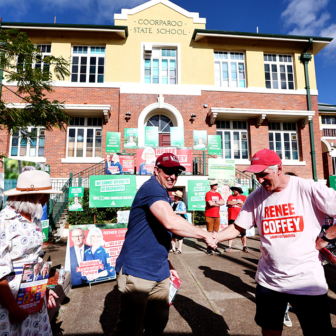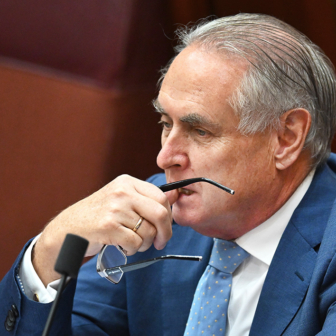In his first term as prime minister Anthony Albanese was confronted by two long-term historical challenges. He prevailed over one of them when his government won an opposition-held seat (Aston) at a by-election for the first time in more than a century. He stumbled at the second when he failed to win a constitutional referendum in the absence of the bipartisan support long necessary (but not always sufficient) for such change.
That failure served Peter Dutton well, providing him with an electoral victory of sorts over Albanese, arguably moving polls towards the Coalition and sparing him some of the leadership rumbles that often bedevil a first-term opposition leader.
Albanese now needs a third historical pattern to prevail. No federal government since 1931 has lost its first attempt at re-election (and that single loss followed the second Labor Party split, induced by the Great Depression). Albanese was a senior member of the Gillard (nee Rudd) government that went close to losing in 2010, necessitating the negotiation of minority government, an outcome widely regarded as quite possible again this time around. In Albanese’s favour, he at least fronts the electorate with a more united team than did Julia Gillard.
Unlike previous first-term governments, Albanese holds a very slim absolute majority: seventy-eight seats to seventy-two (adjusted for redistribution effects), while his advantage over the Coalition is a more comfortable seventy-eight to fifty-seven (counting the seats of two defecting Coalition MPs as Coalition seats). Here, Albanese encounters another pattern: each first-term federal government has suffered a swing but each has had a sufficiently comfortable majority to withstand it. No such solace for Albanese, who would fall into minority status with a net loss of just three seats.
Recent polls have detected a swing back to Labor — probably not yet sufficient to return a majority government — after a sustained run of poor results. This wouldn’t be the only first-term opposition to see encouraging poll leads risk evaporating by election day, perhaps because it is being scrutinised more closely as the election approaches, or perhaps because voters believe in a “fair go” for a first-term government.
Also important is the fact that changes of government are usually preceded by polls forecasting a likely defeat well in advance of the election campaign. Typically, an opposition would be recording a two-party-preferred vote consistently well over 50 per cent, providing some sort of buffer against any swing back to the government during the campaign. No such lead has been established in recent months.
Of course, the two-party-preferred figure is a less useful concept than in the days when one of the major parties emerged from each election with a clear majority of seats, and minor party MPs and independents were a rarity. With the House of Representatives crossbench now numbering fifteen (and with some observers predicting increased numbers), those days are gone.
Outside the traditional Labor–Coalition battles, the national two-party-preferred polls and pendulums will be of limited use in predicting results in three types of contests: seats where the effective contest is Labor versus Green; seats where there is a genuine three-way contest between Labor, Liberals and Greens (notably in the Brisbane area); and seats where teal/community independent candidates will battle (mostly) Liberals. Individual seat polling is likely to be more prevalent than in the past, but should be treated with caution; even more so the notorious “internal party polling,” best taken with a kilo of sodium chloride and a healthy cynicism about the motives of party apparatchiks peddling such findings.
State breakdowns of national polls are somewhat more reliable, with the exception of those relating to Queensland: for some time, there has been a tendency to overestimate the Labor vote in that state, and it’s worth being wary again this time. Other state numbers seem credible enough, with Labor’s Victorian polling well down on its 2022 result, partly reflecting the brand damage done by a long-term and unpopular state government. By contrast, a well-regarded and recently re-elected state government in Western Australia may assist federal Labor to once again secure its highest state-level two-party-preferred vote.
Labor has little to lose in South Australia, meanwhile, where its only marginal seat (Boothby) sits on 3.3 per cent. Without the benefit of credible polling in Tasmania and the Northern Territory, Labor’s vulnerability in Lyons (0.9 per cent) and Lingiari (between 0.9 and 1.7 per cent, depending on preferred choice of redistribution methodology) is merely noted. All of which means that, in the event of an anti-government swing, vulnerable seats in New South Wales and Victoria would seem to constitute the biggest threat to Labor’s narrow majority.
As Rodney Tiffen discussed last week, the impact of campaigns on voting behaviour varies. The most memorable tend to be those where oppositions which had led in the polls lost support during the campaign and went down to defeat, with Labor leader Bill Shorten’s fate in 2019 being the most cited recent example. In the more distant past, Liberal leader John Hewson lost the “unlosable” election in 1993. On each occasion, the opposition had advanced an agenda that could be described in Yes Minister terms as “courageous.” There seems a consensus that no such risks are being taken in 2025.
Unusually for an Australian election, the international environment looms large. On the question of Trump’s tariff impositions, it is unclear whether Dutton’s claim that he could have negotiated a better result for Australia will be seen as credible, especially given Trump’s apparent indifference to alliances and history. For Albanese’s part, his lack of retaliation may be viewed as the most prudent course and it is possible that crisis may ultimately work to the advantage of the incumbent.
On the broader issue of the US alliance, both Albanese and Dutton seem keen to press the “pass” button on the legitimate question of how secure is any alliance under Trump — but if the media are unable to get an answer from the leaders, perhaps they should get a colleague in the United States to ask Trump?
Political hardheads may reasonably contend that the cost of the living remains the key issue in this election and represents Dutton’s best chance of maximising the number of seats he can win. If so, it is puzzling that several of his frontbenchers seem intent on highlighting “woke” issues more appropriate to a Liberal preselection contest than to a national election. Such an appeal to the “base” would make more sense in a system of voluntary voting than in Australia’s compulsory regime, where the “sensible centre” is decisive.
Predictions of minority government have often proved wrong in the past, but unless the current crossbench is considerably pared down in this election, or Labor or the Coalition secure a bigger vote share than polls currently indicate is likely, it is not easy to envisage either side reaching seventy-six lower house seats. While most commentary has focused on a possible minority Labor government, were the Coalition to reach (say) seventy-four seats, a few crossbenchers could probably expect a call from Dutton.
That said, 3 May is still some distance away and the current political atmosphere certainly qualifies as volatile, with some aspects beyond the control of the main local players. Some final notes on history: Albanese is the first PM of the postwar era to lead his party into government and then “go full term”; not since 1914 has any first-up opposition leader after loss of government gone on to be prime minister (and that one — Andrew Fisher — had already been PM twice). Could history await Dutton?
The possibility of minority government can prompt the parties to devise various means of maximising their House numbers; offering the speakership to a crossbencher has sometimes been such a ploy. The prospect of colourful soon-to-be octogenarian Bob Katter swapping his trademark Akubra hat for the speaker’s wig (last worn by Peter Slipper in 2011–12) might provide some light relief in troubled times. •




